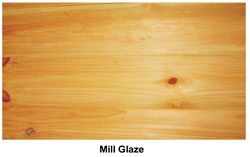If not removed, this glaze can interfere with the adhesion of both water and oil-based coatings since the wood's cellular surface is not in direct contact with the coating. The best way to remove mill glaze from exterior wood surfaces is by using Wood ReNew, a percarbonate cleaner, and pressure washing. We highly recommend this procedure whenever a finish is going to be applied to new exterior siding. For interior surfaces a light sanding (120 grit) followed by a light washing with a Log Wash solution (1/2 cup Log Wash concentrate per gallon of clean water) and wiping the wall with warm water to rinse and remove the detergent from the wood. This action will also help swell and decompress the wood fibers while dissolving the glaze. This assures the adhesion of our finishes to the surface of the wood.
 Perma-Chink Systems, Inc
Log & Timber Home Care Experts
Perma-Chink Systems, Inc
Log & Timber Home Care Experts
What is Mill Glaze?
Although there is some controversy regarding its cause, the most commonly held theory about the formation of mill glaze is that it is created on logs, siding and trim by heat and mechanical compression generated during a high speed milling process. The combination of compressed wood fibers and high temperatures that melt the sugars, cellulose, and other water-soluble extractives present in the wood end up forming a surface glaze.